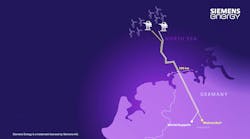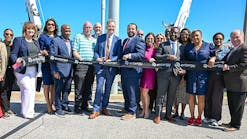Have you noticed how the technologies associated with renewable generation are working together? Energy storage is a key element for solar and wind generation. Grid forming inverters are a critical component for these two renewable energy sources. But it’s HVDC (high-voltage direct current) VSC (voltage source converter) technology that’s moving offshore wind generation into a new era. HVDC-VSC is playing an important part in moving enormous blocks of power extreme distances as all of these pieces of technology come together.
Offshore wind farms have taken renewable energy enthusiasts by storm in North America, but with only two operating offshore wind farms, it’s more about the potential. The Asia-Pacific region’s offshore wind is growing substantially, however the European Union (EU) is attracting most of the attention. Many experts are talking “game changer” when it comes to offshore power production, which shouldn’t be surprising. After all the first offshore wind farm became operational in 1991 about one mile (2 km) off the Denmark coast. It had 11 turbines with a capacity less than 5 megawatts (MW), and the power grid was never the same.
Over the next couple of decades, the capacities of individual offshore wind farms grew to hundreds of MWs, but today’s wind farms are starting to move into the realm of gigawatts (GW). As these behemoths grow in size, they are moving further offshore taking advantage of the higher sustainable winds found there. That, however, complicates connecting them to the grid because of the tremendous distances involved. There was also the issue of the sheer amount of power coming on shore.
Pushing the Envelope
Initially, offshore wind farms used alternating current (AC) technology to bring their power onshore, but there are limitations with AC technology. Without going into a lot of detail, the longer the AC cables become, the higher the charging currents become in the cables. This limits the distances that AC submarine cables can be utilized because of the reactive compensation needed.
On the other hand, HVDC (high-voltage direct current) VSC (voltage source converter) technology has no distance limitations, and they are more efficient at transporting larger blocks of power. So, it should not come as a surprise that developers are using more HVDC-VSC technology when it comes to connecting the onshore grid to these distant wind farms.
Last year, Ørsted announced they had awarded Hitachi Energy a contract to provide two HVDC-VSC systems to connect the 2.85 GW Hornsea 3 wind farm to the United Kingdom’s (UK) power grid. Hornsea 3 is located roughly 99 miles (160 km) off the Yorkshire coast. It will have more than 200 wind turbines and cover almost 270 sq miles (700 sq km) It is scheduled for commissioning in 2027. The Hornsea 3 is a significant step towards the UK’s goal of deploying 50 GWs of offshore wind generation by 2030.
Earlier this year, the German transmission system operator Amprion awarded a contract to the consortium of Siemens Energy and Dragados Offshore to build HVDC-VSC systems for two offshore grid connections in Germany. Each grid connection will transport up to 2.0 GW of offshore wind power to the onshore power grid. Their combined transmission capacity of 4.0 GW will connect several wind farms in the North Sea to the German transmission grid. They are expected to be in service as early as 2029 and 2030 respectively.
These systems will be used by the BalWin1 and BalWin2 (formerly LanWin1 and LanWin3) grid connection projects. Each system is designed to move the renewable offshore energy to the German power grid via separate HVDC submarine/underground cable systems. These two cable systems are approximately 242 miles (390 km) in length. The land-based HVDC-VSC stations are being built near Wehrendorf in Lower Saxony and Westerkappeln in northern North Rhine-Westphalia.
Dragados Offshore is responsible for the construction and offshore installation of the associated German North Sea platforms. Siemens Energy’s scope of supply consists of the complete equipment for two HVDC-VSC systems on the platforms in the North Sea and two associated HVDC-VSC stations onshore. Siemens Energy will also maintain the HVDC-VSC systems for 10 years.
A Deeper Dive
These sophisticated HVDC-VSC offshore/onshore systems have a high degree of complexity that isn’t easily understood. With that in mind, “Charging Ahead” went to a specialist. We spoke with Hauke Jürgensen, senior vice president Grid Solutions at Siemens Energy to get an expert’s perspective of what is taking place with the technology. Jürgensen started off saying, “When Germany started utilizing offshore wind farms about 2010, the generation capacities were only in the hundreds of megawatts and closer to shore.”
Continuing, Jürgensen said, "Today, however, there are approximately 8.1 GWs of offshore wind generation connected to the German grid currently, and it’s further from land adding additional layers of difficulty. Also, Germany’s “Offshore Wind Energy Act” has increased the goals with a target of connecting 30 GW of wind generation to the grid by 2030. That is a very ambitious timeline, and it requires taking advantage of all the current technology available while developing additional innovative approaches to make it happen.”
Jürgensen stated that, “Siemens Energy’s approach for the BalWin1 and BalWin2 grid connection projects represents a distinctive philosophy to increase the scale of HVDC transmission schemes. This advancement is based on proven 900 MW HVDC-VSC platform technology found in previous Siemens Energy projects. By utilizing a bipolar configuration design, the new systems can be operated at twice the voltage and transmit twice the power. For these grid connections projects that represents an increase to 2.0 GW in each systems’ transmission capacity, but more is needed.”
Jürgensen explained, “By designing these offshore HVDC-VSC platforms to function as HVDC interconnection hubs (editor’s note, artificial energy islands), there would be increased flexibility for moving offshore power to where it’s needed. This would provide a multi-terminal HVDC mesh grid, but one thing is crucial for this. This approach is going to require all the manufacturers of HVDC-VSC systems to work together.”
He continued, “Current HVDC-VSC schemes still are somewhat proprietary “black-box” systems. A system from vendor “X” does not immediately work with equipment manufactured by vendor “Y” and vice versa. There isn’t the ability for mix and match systems, but that is about to change. In January 2023, the EU kicked off the InterOPERA project to make future HVDC systems mutually compatible and interoperable by design. A crucial requirement needed to realize a meshed DC grid and to bring renewables even more efficiently to the load centers.”
Jürgensen concluded, "The multi-terminal technology itself has progressed quite far, but it will take some time for the industry to do the necessary research and development and – especially - to agree on the best possible technical standards for multi-vendor HVDC schemes. Siemens Energy is going to be very proactive in this process. HVDC is a key technology in a decarbonized energy landscape, and we are facing correspondingly ambitious grid expansion plans.”
Continuing, “At the same time, renewable energy projects worldwide continue to suffer from challenges such as long lead and approval times or an increasing shortage of skilled workers and engineers. We have every means at our disposal to overcome the challenges, but business, politics and society must work closely together so that current technologies can be deployed in the most efficient way and at the same time innovations can be driven forward. The introduction of technical standards that enable the interoperability of HVDC networks from different suppliers is just one building block that brings us closer to reaching climate targets.”
Critical Technology
Multi-terminal technologies are also important to another cutting-edge application known as artificial energy islands. Interest is growing in the EU and there have been several projects announced lately to build islands in the North Sea and the Baltic Sea. One such comes from Belgium’s transmission service operator Elia. They plan to develop a multi-functional artificial energy island in the North Sea approximately 28 miles (45 km) off the Belgian coast. The island will be an electricity hub connecting wind farms and European countries.
Another comes from Denmark. They are building two energy islands. One will be built on Bornholm Island in the Baltic Sea. The other will be an artificial energy island built approximately 62 miles (100 km) from the Danish mainland in the North Sea. Wind Europe reported that Germany and the Netherlands are also working on energy islands. They indicated that energy islands will play a “huge role in Europe’s future energy system.”
The latest EU offshore wind energy target for 2030 is 60 GWs and that’s expected to be revised upward and figures like 450 GWs are being kicked around for 2050. HVDC-VSC, interoperability, mesh-grids, artificial energy islands, and other advanced technologies are going to play a critical part in meeting the EU goals. It’s like a technological jigsaw puzzle with all the pieces finally falling into place to have the power grid extended offshore!


